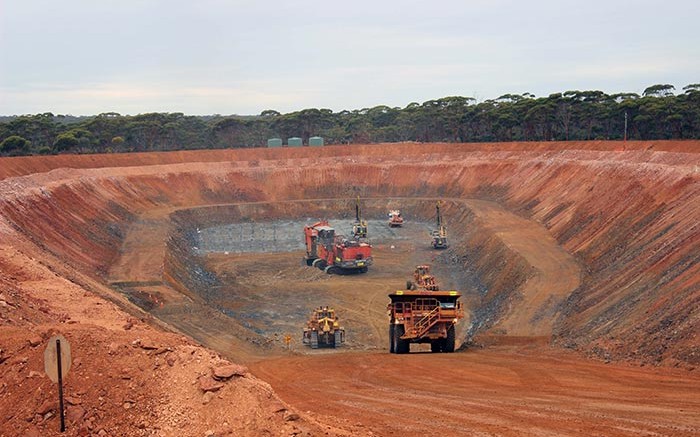VANCOUVER — It’s been two and a half years since Mark Bennett, managing director and CEO of Australian-explorer Sirius Resources (ASX: SIR; US-OTC: SRQUF), struggled to keep his 5¢-per-share company above water.
Now, boasting a $1-billion market capitalization, A$189 million in fresh equity and A$245 million in cash, the aspiring nickel miner owes its success to pursuing early stage exploration opportunities and applying creative ideas.
“We went looking for a star nickel deposit that’s never been found in Australia,” Mark Bennett tells The Northern Miner during a phone interview from Perth. “It was an unusual idea with big expectations, but we had ground with all the right ingredients, and we found it.”
In 2012, Sirius discovered the Nova-Bollinger nickel-copper deposits, 200 km east of Norseman, Western Australia. The discovery defined a new style of magmatic nickel-sulphide mineralization in the heart of the Goldfields — an Archean province hosting up to 30% of the world’s known gold reserves and equally significant nickel-copper resources.
“It literally came down to the wire,” Bennett says, recalling the project’s early days. “Nova looked too good to be true, so we took what money we had left and threw it on a drill program. I was driving to Perth with the discovery hole in the back of the truck when I got an email from an affiliate of the Australian Securities Exchange asking for an explanation about how our company could possibly survive any longer. All I could do was laugh, because it was so ironic.”
Sirius is set to put the deposit into production by next year, and Bennett says the timing couldn’t be any better.
“The mining boom is over, and business expectations are quickly returning to normal. Things cost a lot less now, and come a lot quicker too,” he explains.
It has already saved A$30 million on mine-construction costs and scored a A$420-million facility with no mandatory hedging. Bennett says he looks forward to seeing what other cost-savings might be on the way as the mine enters production.
Nova-Bollinger has total proven and probable reserves of 14.2 million tonnes of 2% nickel, 0.8% copper and 0.07% cobalt, and could be mined at a rate of 1.5 million tonnes annually over an initial 10-year mine life may be extended with underground exploration.
The company doesn’t want to commit to production numbers yet, but according to a definitive feasibility study completed in 2014, average annual production following project ramp-up would be 26,000 tonnes nickel and 850 tonnes cobalt in a nickel concentrate, and 11,500 tonnes of copper in a separate copper concentrate.
In February, Sirius signed a three-year offtake deal to supply half of its nickel concentrate from Nova to BHP Billiton’s (NYSE: BHP) Nickel West facilities, located within trucking distance in Kambalda, Western Australia, starting in 2016. Sirius hopes to allocate the rest of its concentrate output by mid-2015, and said in February it was in discussions with a third party.
Anticipated capital expenditures amount to A$443 million, and the mine might operate at a cash cost of US$1.50 per lb. payable nickel.
But the soon-to-be producer isn’t stopping there. Aside from a slew of promising early stage nickel targets in its exploration portfolio, Sirius announced a gold discovery in late January at its Baloo prospect, 45 km north of Norseman.
Intercepts included 33 metres of 3.8 grams gold per tonne across a 750-metre long oxide zone near surface.
The shear-hosted gold deposit sits blindly underneath a 50 km salt lake surrounded by prospective greenstone belts, endowed with over 30 million oz. gold. But unlike other deposits in the region, it’s hosted in a part of the stratigraphy other explorers presumed barren.
Recognizing the new potential, Sirius staked another 300 sq. km of ground east of Baloo that shares similar geology.
“Three years ago you would never see open ground in the Goldfields — it’s a sign of the times, really,” Bennett says.
In the meantime, Sirius has a A$15-million exploration budget going towards its nickel and gold targets this year. Part of it will be used to test extensions of Baloo at depth, along with a resource drill-out that’s scheduled to begin within the next couple of months. Bennett has confidence the new deposit will eventually become an open-pit mine: “It’s just a question if it’ll be a little one or a big one.”
But despite all the success, Bennett is down-to-earth about what it takes to be different than the rest.
“In larger companies there’s a lot of internal competition, slower decision making and more uniformity that strips individuals of their creativity. The bigger the company, the more of it. To make a discovery you need to think out-of-the-box, and the explorers who do this best are often highly imaginative. If you force their thinking into a corporate pigeonhole, it’ll destroy them, and you’ll never achieve the result you’re after. In our company, we balance our objectives with a fresh look at things. We value our employees and strive to make their ideas grow.”


Be the first to comment on "Sirius pushes Nova towards production in Australia"